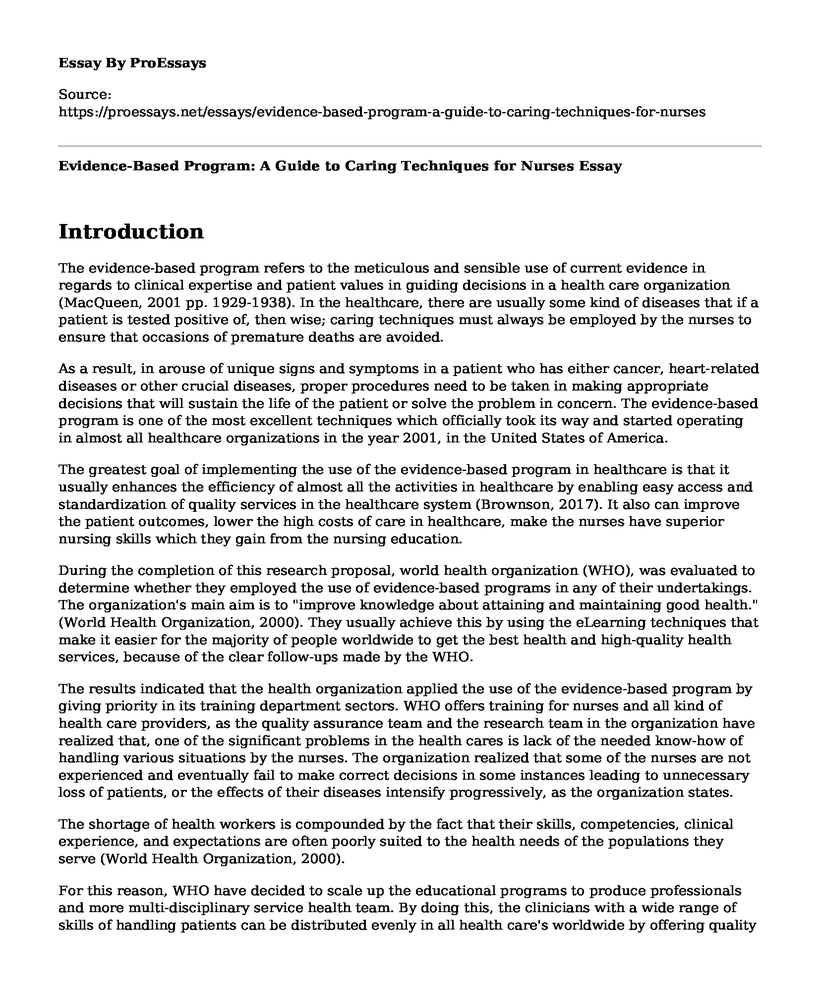Introduction
The evidence-based program refers to the meticulous and sensible use of current evidence in regards to clinical expertise and patient values in guiding decisions in a health care organization (MacQueen, 2001 pp. 1929-1938). In the healthcare, there are usually some kind of diseases that if a patient is tested positive of, then wise; caring techniques must always be employed by the nurses to ensure that occasions of premature deaths are avoided.
As a result, in arouse of unique signs and symptoms in a patient who has either cancer, heart-related diseases or other crucial diseases, proper procedures need to be taken in making appropriate decisions that will sustain the life of the patient or solve the problem in concern. The evidence-based program is one of the most excellent techniques which officially took its way and started operating in almost all healthcare organizations in the year 2001, in the United States of America.
The greatest goal of implementing the use of the evidence-based program in healthcare is that it usually enhances the efficiency of almost all the activities in healthcare by enabling easy access and standardization of quality services in the healthcare system (Brownson, 2017). It also can improve the patient outcomes, lower the high costs of care in healthcare, make the nurses have superior nursing skills which they gain from the nursing education.
During the completion of this research proposal, world health organization (WHO), was evaluated to determine whether they employed the use of evidence-based programs in any of their undertakings. The organization's main aim is to "improve knowledge about attaining and maintaining good health." (World Health Organization, 2000). They usually achieve this by using the eLearning techniques that make it easier for the majority of people worldwide to get the best health and high-quality health services, because of the clear follow-ups made by the WHO.
The results indicated that the health organization applied the use of the evidence-based program by giving priority in its training department sectors. WHO offers training for nurses and all kind of health care providers, as the quality assurance team and the research team in the organization have realized that, one of the significant problems in the health cares is lack of the needed know-how of handling various situations by the nurses. The organization realized that some of the nurses are not experienced and eventually fail to make correct decisions in some instances leading to unnecessary loss of patients, or the effects of their diseases intensify progressively, as the organization states.
The shortage of health workers is compounded by the fact that their skills, competencies, clinical experience, and expectations are often poorly suited to the health needs of the populations they serve (World Health Organization, 2000).
For this reason, WHO have decided to scale up the educational programs to produce professionals and more multi-disciplinary service health team. By doing this, the clinicians with a wide range of skills of handling patients can be distributed evenly in all health care's worldwide by offering quality services, as highlighted in the organization's top aims. The world health organization is currently working with stakeholders from various fields to determine clearly the most appropriate way of improving the workforce by increasing both the quantity of health professionals, and the quality of services offered to patients which will definitely come after dealing with the issue of quantity of health experts in health cares, by probably opening up more training and secure accessible institutions for educating nurses.
Conclusion
Personally, the information obtained from the website of the organization impressed me, because initially, I did not think that the organization also dealt with the issue of the question of how many health care providers are present in a nursing home? I had known WHO for checking the quality of what the patients were getting in the nursing homes. I had initially directly linked the question of how many health care providers present in an organization to be part of the priorities of the various labor departments in the world. This is a wrong assumption because it does involve in ensuring that appropriate workers who can deliver quality services are present in healthcare.
References
World Health Organization. (2000). The world health report 2000: health systems: improving performance. World Health Organization.
MacQueen, K. M., McLellan, E., Metzger, D. S., Kegeles, S., Strauss, R. P., Scotti, R., ... & Trotter, R. T. (2001). What is a community? An evidence-based definition for participatory public health. American journal of public health, 91(12), 1929-1938.
Brownson, R. C., Baker, E. A., Deshpande, A. D., & Gillespie, K. N. (2017). Evidence-based public health. Oxford University Press.
Cite this page
Evidence-Based Program: A Guide to Caring Techniques for Nurses. (2023, Jan 16). Retrieved from https://proessays.net/essays/evidence-based-program-a-guide-to-caring-techniques-for-nurses
If you are the original author of this essay and no longer wish to have it published on the ProEssays website, please click below to request its removal:
- Essay Sample on Cosmetic Surgery
- Research Paper on Issues Facing National and Global Food Systems
- Rural Health Management - Essay Sample
- Essay on Clinical Interviewing: Examining Intake, Assessment & Therapeutic Alliance
- Essay Example on Osteocytes & Chondrocytes: The Cells of Skeletal Tissues
- Ethical Dilemma in Withdrawing Life-Sustaining Treatment for Severely Disabled Infants - Research Paper
- Essay Example on New Sweet Odor in Diapers: Further Info Needed







